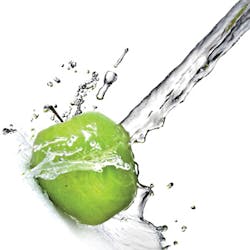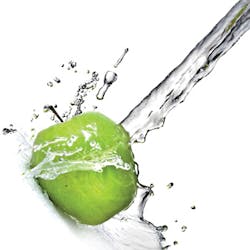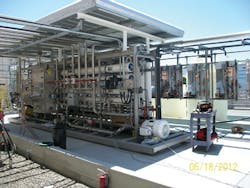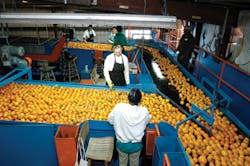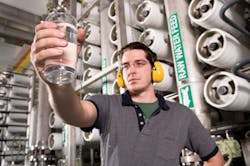Challenges, Opportunities for Water Reuse in the Food & Beverage Industry
By L.K. Williams, Industrial WaterWorld Correspondent
Just how many food and beverage (F&B) plants are treating process wastewaters for reuse onsite? That depends on who you ask. Consultants base their answers on their experiences, which are as varied as the industry itself. Our experts agree, however, that the priorities of F&B processors are to keep their products safe from contamination and to protect a healthy bottom line.
Using treated process wastewater in direct contact with a food product is taboo. Public perception of what is "clean" and "safe" has made F&B companies a cautious crowd. Today's F&B processors most often reuse treated wastewater in non-food-contact environments.
Greg Koch, managing director, global water stewardship, The Coca-Cola Company, outlined how his facilities operate. "We reuse water only in non-product applications for bottling plant activities, such as irrigation of landscaping, truck washing, cooling towers, and warehouse floor washing. Increasingly, we also are collecting, treating for safety, and reusing water from specific processes, but never using the collected water for product water," Koch said.
This approach maximizes water savings in a way that doesn't interfere with the primary concerns of F&B processors.
Koch was willing to share his company's numbers for water reuse. "At this time, approximately 86 production facilities (39 percent overall facilities) across The Coca-Cola Company have indicated that they reuse water or use collected rainwater, and 49 facilities (22 percent of overall facilities) have entered some statistics for the amount of collected rainwater or water reused after treatment."
In 2010, he added, water reused in boilers, evaporators, chillers, irrigation, and dust control, helped the company reduce its external water sources by nearly 18 percent.
The beverage sector (breweries, dairies, soft drink facilities and even bottled water plants) may be motivated to reuse process waters simply because their products are made mostly of water. Direct product contact with treated wastewater could never be considered viable, not as long as public perception is what it is today. But it is possible to do so safely.
"We know that the technologies exist to create water that is equal to or better than many source water qualities," said Andrew Eaton, Ph.D., technical director at MWH Labs. A National Research Council report in January confirms Eaton's claim. The council reported that "analyses suggest that possible health risks of exposure to chemical contaminants and disease-causing microbes from wastewater reuse do not exceed and, in some cases, may be significantly lower than the risks of existing supplies."
The industry challenge is to convince the public that process wastewater can be treated to a quality that is higher than some municipal drinking water. Some sources believe that the public will accept such practices over time, especially in locations where clean water is in short supply.
Water reuse: The neglected child
The United States government has no national standards for water reuse. In 1999, the U.S. Department of Agriculture's Food Safety Inspection Service (FSIS) established regulatory sanitation performance standards applicable to all official meat and poultry establishments. These standards only suggest that facilities can reuse water with proper monitoring and/or treatment with cooking and chill water, chiller overflow, and in condensers and compressors.
The U.S. Environmental Protection Agency's 2004 Guidelines for Water Reuse focuses on municipal water reuse. An updated version of this guidance document, scheduled for release later this year, includes a section on "Prepared Food Manufacturing." It describes the use of water in processing facilities, the opportunities for reuse, and the technologies in use, including some that not only recover water but also product components that can be used in other markets and provide additional revenue. While this information is interesting and even helpful, some experts say the federal government should develop regulations that provide reasonable, consistent standards simply because food crosses state lines.
To manage food product contamination proactively, FSIS adopted the hazard analysis and critical control points (HACCP) program. Facilities develop detailed plans of their processes to help identify and control biological, chemical, and physical hazards. The program, a few experts say, indirectly regulates water reuse. In 2005, FSIS instructed poultry processors that if water was to be reused in a facility, this process had to be accounted for in the HACCP plan.
According to Brian H. Kiepper, Ph.D., professor of poultry science at the University of Georgia, the HACCP rule's food safety targets required poultry processing plants to significantly increase their water use. The rule, he said, combined with dwindling supply due to drought and other factors drove poultry plants to install water reuse systems to fill the supply gaps. HACCP plans are mandatory for meat and poultry, juice processing and packaging, and fish and seafood but are expected to be required for others in the future.
"I do think [HACCP] is inherently considered by facilities evaluating water reuse," said Albert Goodman, principal at CDM Smith. His company designed a program for water reuse within an award-winning food processing facility in Casa Grande, Ariz. "Food safety and quality are of paramount importance to manufacturers," he said. "Water reuse has to be tested internally and externally by rigorous analytical methods to ensure product quality, taste, texture and similar integrity of brand and quality along with implementing redundant and efficient treatment components to ensure safe and continuous water treatment."
As a result of unfocused federal action, the rules rest with the states. Twenty-five have regulations, 16 have guidelines and 9 states have no rules for water reuse, explained Jon Freedman, vice president of government affairs & policy at GE Water. He said this information comes from the WateReuse Foundation, the research arm of the WateReuse Association. (Freedman chairs the association's Industrial Reuse Committee with Eric Rosenblum of Envirospectives.)
Treatment and Technology
Despite a lack of strong regulatory attention to water reuse, F&B processors are employing various levels of treatment and technologies as conditions merit.
"Almost all food and beverage companies of any significant size are now using measured water ratios, monitoring water consumption and have strategies and goals for minimizing water usage," said Goodman, who has more than 35 years of experience with industry. Common treatments include screening and grease capture, dissolved air flotation, primary clarifiers for suspended solids removal, pH adjustments and lagoons, he said.
Koch noted that The Coca-Cola Company and the World Wildlife Fund developed and distributed Water Efficiency Toolkits to its manufacturing operations. The toolkit enables plants to compare their water use ratio across the system and presents more than 100 possible solutions to improve water use efficiency.
Small facilities may be taking much smaller steps: measuring water usage between work shifts, installing flowmeters or leak detection systems, and adding spring valves to hoses, said Brian Bzdawka, a Woodard & Curran business development manager for operations and management. These simple practices conserve water. Success in this area may encourage managers to expand their best management practices and include water reuse applications.
"At the very least, beverage plants employ some type of pH neutralization because their cleaning processes generate caustics," said Lloyd Snyder, P.E., a senior vice president at Woodard & Curran with 19 years' experience with the F&B industry. "They also use flow equalization technologies to prevent surges to the municipal wastewater treatment facility."
F&B companies that have measured performance goals and benchmarks for water reductions are at an "intermediate" water reuse level, Goodman suggested. "These may also include facilities that are irrigating crops and using water in cooling towers without food contact." Many F&B processors use activated sludge with secondary clarifiers, especially if they discharge their effluent to streams. Anaerobic lagoons followed by aerobic or facultative lagoons are also common, especially where land is available.
An Uncommon Exception
Very few companies have adopted "advanced" technologies, such as membrane bioreactor (MBR) technology, Goodman said. But he has had the chance to be involved with one that does -PepsiCo Frito-Lay's snack manufacturing facility in Casa Grande. The "near net zero" waste discharge facility won a U.S. Water Prize from the Clean Water America Alliance earlier this year. In 2011, the WateReuse Association recognized the facility.
"Frito-Lay is currently the only facility treating wastewater with MBR to advanced biological nutrient removal plus having an advanced drinking water treatment technology with granular activated carbon, ultraviolet light disinfection, and reverse osmosis (RO) technologies all in use," Goodman said.
The 650,000 gpd process water recovery treatment plant recycles up to 75 percent of the plant's process water, allowing the company to lower water use by 100 million gallons annually according to published reports.
"This is the most ambitious water reuse to EPA drinking water quality for direct food contact by any food and beverage company in the U.S.," Goodman said. "It was a strategic investment made by Frito-Lay and PepsiCo to demonstrate both internally and externally that the technology exists, is applicable and can be utilized effectively for areas where groundwater is scarce, costly and maybe unavailable in the future."
Frito-Lay treats water to EPA primary and secondary drinking water standards for reuse in cooking corn, washing potatoes and in cleaning/sanitation of their production equipment.
While the snack food processing facility established what can be achieved, this system will not likely be replicated industry-wide. Instead, processors will adjust their operations according to their circumstances and needs.
Snyder said he worked on a project with a Coca-Cola bottling plant in which the local community supplier restricted water use for the plant's product. With the addition of an RO system and ultraviolet disinfection to its current anaerobic process, the plant was able to make better use of its water supply.
"The bottler had been using drinking water quality water to spray-cool heated bottles. That water was used only one time. With the onsite treatment plant expansion, that spray water can be used again for its original purpose or [as makeup water] for its cooling towers," he said.
The bottler invested about $3 million for the system to increase its production despite city-imposed water limitations.
"With the world facing water scarcity issues and the cost of water rising, we're continually working with our bottling partners to improve our water use efficiency and reuse strategies by incorporating innovative solutions into our manufacturing processes," Koch said. "Through these efforts, we've improved our system-wide water use efficiency by 16.3 percent across eight consecutive years of progress."
Standards and Consistency
The F&B industry and other water stakeholders are developing their own voluntary guidelines. Some of that work is being done through the Industrial Reuse Committee and an International Life Science Institute (ILSI) core group. Eaton is working on a beverage standard through ILSI.
The Industrial Reuse Committee, which only started meeting in March 2011 as a California-centered group has already expanded into a national committee and identified five focus areas, one of which is food processing, Rosenblum said. More than 60 members are now involved in planning workshops, organizing studies and promoting sustainable water reuse.
Freedman is engaged in initiatives that would benefit water reuse, including legislation that would remove the cap on private activity bonds. Freedman said that the committee also advocates an investment tax credit for water reuse equipment.
Eaton, who refers to himself as "a cog in the wheel," said the ILSI standard is designed to be used by a variety of beverage facilities with different potential volumes of possible reuse water and with different potential uses. He explained that a table in the standard, scheduled to be released at the end of the year, lists various technologies that may be used and what contaminants they are good at controlling.
"RO with high recovery ratios is very common as a treatment, and MBRs are beginning to be used more frequently," Eaton said, adding that the guideline includes several successful water reuse case studies.
Poultry Processing Perspective
Comprehensive data on the number of F&B facilities reusing wastewater is hard to come by, partly because they are not strictly regulated. EPA estimates that water reuse in meat and poultry processing (MPP) facilities is relatively rare, but actual on-the-ground experience indicates otherwise.
Only 8 percent of poultry processors participating in a detailed MPP survey indicated they reuse water from the wastewater treatment plant in their defeathering or evisceration areas, according to the 2002 "Development Document for the Proposed Effluent Limitations Guidelines and Standards for the Meat and Poultry Products Industry Point Source Category." Even less common is effluent reuse for screen washing or cleaning outside areas, the agency says.
However, Brian H. Kiepper, professor of poultry science at the University of Georgia, said his experience challenges EPA's assessment of water reuse in the poultry processing industry.
"Of the approximately 160 broiler slaughter plants in the U.S., I have been in well over 50 of those. I personally have never been in a poultry processing plant that didn't reuse water in some fashion," he said.
Kiepper explained that, for decades, plants have recycled a portion of the wastewater to transport feathers through the facility. They also employ "redwater rechilling systems" that pump water from the poultry carcass chiller to a screening, filtration and disinfection treatment system and return this treated water to the chiller.
"This was one of the first product contact water reuse systems introduced to the poultry processing industry," he noted, adding that it has been in use for about 30 years. The primary goal of most rechilling systems is to conserve energy, he added.
As an example of current projects in the poultry industry, the GNP Company last year upgraded its biological phosphorus and ammonia nitrogen removal systems. It also installed membrane bioreactors to the 1 mgd wastewater treatment plant at its Cold Spring, Minn., chicken processing facility. According to the company's "Farm to Fork" report, the MBRs effectively controlled the turbidity, allowing for the reuse of the discharged wastewater at the facility in noncontact areas.
"Specifically, we can reclaim about 300,000 gallons of the treated water each day for uses such as watering the lawn and landscaping around the building. We have also started working with the U.S. Department of Agriculture and other government agencies to determine the potential of using treated water in other areas of the plant," the report states.
